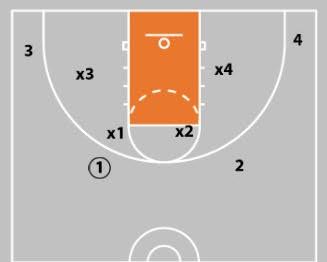Teach Players When and Why to Dribble (instead of Over-Dribbling!) with This 4v4 Drill
After 16 years as a varsity basketball coach, I am coaching 7th grade boys this year.
If points were awarded for dribbling, we’d be unstoppable! It’s a disease that has infected most of my players - they often dribble aimlessly.
I am not sure where they acquired this habit, but I know I have to break it.
Come to think of itI do know where they acquired it - youth basketball. It’s where they learned how to play offense.
And I’ve seen this with all the youth basketball teams I’ve coached.
Kids dribble because they don’t know what to do. Kids dribble when they get pressured. Kids dribble all the time!
You need to break that habit to become a more effective offensive team. That’s one aspect that is focused on in The Youth Coaching System With Jim Huber.
The Issue With “No Dribble” Drills
Some coaches like to use “no dribble” offense drills. Those drills do serve some purposes:
- Improved passing
- Improved pivoting & ball security
- Improved cutting
Those are valuable skills. If you find that players are struggling in those areas, try some no dribble drills.
However, they may not be the best way to solve over-dribbling.
Why? Because the goal isn’t for players to never dribble. The goal is for players to use the dribble effectively.
4 Reasons You SHOULD Dribble
If the goal is to use the dribble more effectively, players must understand when to dribble.
Players should use the dribble in the following situations:
- To attack the basket when they have an advantage.
- To improve a passing angle.
- To release pressure.
- To advance the ball in transition.
Once players know when to dribble, they need practice applying those reads. To train that, try the following drill.
4v4 2 Dribble Limit Drill
Set up to play 4v4.

- Players play normal 4v4.
- Offensive players are only allowed to dribble 2x every time they get the ball. If a player dribbles more than 2x, it’s a turnover.
Coaching Tips:
- On every catch, make sure players square up to the rim.
- The first thought is to shoot if they are open and in range.
- If they can’t shoot, they should look for a pass to a player at the rim.
- If there is no one open inside, they should look for a perimeter pass.
- Make sure players are using the dribble for one of the purposes listed above. If not, provide corrective feedback.
- The players without the ball must recognize if their teammate needs space or support. Generally, if they haven’t used their dribbles, they need space. If they’ve used up their dribbles, they need support.
- If players are going to use the dribble, encourage them to do so on the catch. That gives them the opportunity to attack a closeout.
The Goldilocks Benefit Of The 2 Dribble Limit
When players have unlimited dribbles, it’s hard to reign them in.
When players have no dribbles, they don’t get the chance to learn how to use their dribble effectively.
By giving them 2 dribbles, they are constrained in a way that forces them to think about when and how to use their dribble.
That self-awareness is a key aspect to building players with high basketball IQ.
For more drills that build smart players & winning offensive habits, check out The Youth Coaching System With Jim Huber.
What do you think? Let us know by leaving your comments, suggestions, and questions...
|
|||


 Facebook (145k Followers)
Facebook (145k Followers) YouTube (152k Subscribers)
YouTube (152k Subscribers) Twitter (33k Followers)
Twitter (33k Followers) Q&A Forum
Q&A Forum Podcasts
Podcasts